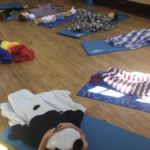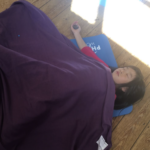If we were able to harness mindfulness and meditation from an early age, what would the world look like? Imagine learning these tools as a young child and then being able to use them for your entire life.
In today’s high tech, fast paced world, it’s pretty easy to become over stimulated. Electronic devices constantly in our hands and busy schedules can make cultivating inner peace seem like a distant destination. Enter tension and fatigue. This is true for us adults, so imagine children as they absorb the energy of their parents and of the environment which they live in. Then, we send them off to school, where they are expected to concentrate and focus. We all love our children so why not give them a tool that can help them become more mindful and better able to cope with all that falls in their paths?
Meditation (or mindfulness practice) is a beautiful way to stay grounded and present, so that we can savour the good times whilst better managing the more trying ones. It helps us to stay connected with our true essence and build self worth and self love. There have been many studies to prove that meditation and mindfulness are good for us and link to better concentration, increased focus, and a better functioning memory.
On the emotional side meditation lessens worry, anxiety and impulsivity. It also lessens stress, fear, loneliness and depression (as does yoga!). It can enhance self-esteem and self acceptance. A regular meditation practice can help to improve mood, optimism, emotional intelligence, relaxation and awareness.
Looking at the brain; meditation can help to increase mental strength and focus, increase memory retention and recall, and can help manage ADHD. Through a regular practice it’s possible to gain better cognitive skills and creative thinking, better decision and problem solving and better information processing.
On the physical body side, meditation can improve the immune system and energy levels, and it can help improve breathing and heart rates. The biggest benefit I have found through teaching meditation to others is creating an awareness in the individual, and the ability to witness rather than get involved in thoughts and emotions. For children; this is of huge benefit to them to be able to cope with the intensity of their feelings and the pressures in their lives and also just to be comfortable in their own skin.
Having discovered yoga and meditation in my twenties and thirties, I always wished I had found it earlier, and so having the opportunity to teach yoga and meditation to children now is a great honour.
To introduce meditation to children I usually have an informal chat/discussion with them and begin by asking them questions such as ‘What is meditation?’ and ‘what are the benefits?’ and ‘how would we go about creating our own meditation space at home?’ I suggest that they find a special place at home that will be their meditation spot, and to make it welcoming with their own cushion or pillow. I encourage them to find a few small simple items that have special meaning to them such as a family photo, their favourite artwork, a crystal or perhaps a plant. In class I sometimes give out mandalas to colour in which they can also use in their little haven of peace.
Another option is to bring some pebbles from the beach and ask each child to choose two pebbles, one for each hand. The pebbles can also be placed on their tummy to help focus on the rise and fall of the belly in breath work.
There is a wonderful book called ‘A Handful of Quiet’ by Thich Nhat Hanh which is all about pebble meditations for children, and recommends each child has four pebbles. Each pebble represents a different image in nature: a flower, a mountain, calm water, and space.
For children’s meditation I suggest using a timer (we do this in class but I use chimes or a Tibetan singing bowl). Having a timer is nice because for the child they know to expect and end time.
Seated meditation is great, but being comfortable is so important. Keeping the eyes closed allows for deeper relaxation although there is no right or wrong.
Focussing on breath is key; simply noticing the breath on the inhale and on the exhale and then encouraging long, deep, slow breaths where their belly rises up on the inhale and contracts to small again on the exhale. A Fun Visual: Blowing out the candle. The child/ren can clasp their hands together and raise their two index fingers, holding them infront of their mouth, inhaling slowly and deeply. On the slow exhale, they imagine blowing out a candle…. Blowing out a birthday candle is something that all children can usually relate to.
I would recommend all parents to give meditation a go with their children and try to make it a regular healthy habit to carve into their day. For younger children you can perhaps offer a game or some reward after a meditation which for young children is best to keep to 2 – 5 mins.
Sitting still may not come naturally or easily at first and it’s okay for minds to wander or bodies to be fidgety, but encouragement to try their best to relax is key. Children should know that over time and with a regular practice, they will be able to sit still longer and they will begin to experience many of the other wonderful benefits that meditation has to offer.
Meditation has been scientifically proven to be good for us in so many ways, so why wouldn’t we want to teach it to children!
The way I adapt meditation for children is to make it very visual, sometimes in the form of a story. It is so wonderful to watch when the children become totally relaxed and focussed. It is a total honour to have the opportunity to teach children meditation and yoga.
Children’s yoga and meditation classes with Jess are held every Wednesday from 4.30pm – 5.30pm in Seal.


Leave a Reply